piano
-
Fürstenau - Adagio et Rondo Brillant - Fl & Pf
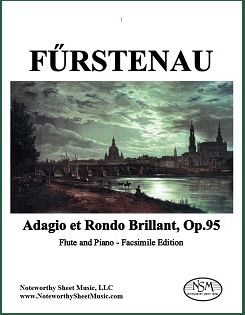 Adagio et Rondo Brillant, Op.95, by A. B. Fürstenau
Adagio et Rondo Brillant, Op.95, by A. B. FürstenauGassett Collection - Facsimile Edition by C.A.Vater/Noteworthy Sheet Music with a Foreword by Peter H. Bloom
Flute Part and Piano Score, PDF $12.00
Anton Bernhard Fürstenau (1792-1852) was among the most revered flutists of the 19th century. Following his appointment to the post of principal flute for the Royal Chapel at Dresden in 1820, Fürstenau became a valued colleague and close personal friend of the court's music director, Carl Maria von Weber. The influence of Weber's dramatic melodic gestures and edgy harmonic shifts can be heard in this passionately evocative Adagio et Rondo Brillant. An NSM favorite!
For additional information about the Gassett Collection, please see see our article An Introduction to the Gassett Collection.
Piano score, 12 pages; Flute part, 4 pages; Total, 20 pages.
Preview -
Gabrielsky - Adagio et Variations - Fl & Pf
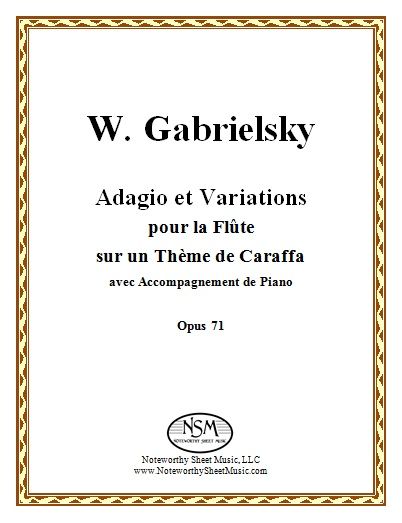 Adagio et Variations pour la Flûte sur un Thême de Caraffa, Op. 71, by W. Gabrielsky
Adagio et Variations pour la Flûte sur un Thême de Caraffa, Op. 71, by W. GabrielskyGassett Collection - New Edition by Noteworthy Sheet Music
Flute Part and Piano Score, PDF $18.75
Johann Wilhelm Gabrielski (or Gabrielsky), 1795-1846, was an acclaimed German flutist and composer from Berlin. In 1814 Gabrielski secured a position as flutist at the theatre in Stettin and within two years was appointed to the Royal Court. Gabrielski's compositions, of which there are more than 100, were highly esteemed and popular in his day. Although these works have much to offer modern day flutists as well, Gabrielski's music is neither widely known nor readily available today. The Adagio et Variations pour la Flûte, Op. 71, exploits melodic material by Michele Enrico Carafa (Caraffa) di Colobrano (1787-1872), a Naples born musician who had a remarkably successful career in Paris as a composer for the Opéra-Comique and as a professor of composition and counterpoint at The Conservatoire. The work showcases the flutist's virtuosity, atop a relatively uncomplicated piano accompaniment.
For additional information about the Gassett Collection, please see see our article An Introduction to the Gassett Collection.
Flute part, 11 pages; Piano Score, 16 pages; Total, 31 pages.
Preview -
Gade - Fantasy Pieces - Alto Flute
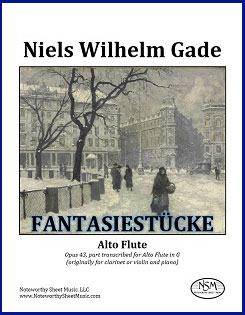 Fantasiestücke, Op.43, by Niels W. Gade
Fantasiestücke, Op.43, by Niels W. GadeTranscribed for Alto Flute and Piano by John W. Pratt
Alto Flute Part, PDF $6.99
Niels Wilhelm Gade (1817–1890) became the preeminent figure in 19th century Danish musical life after an early success in Copenhagen and five years in Leipzig as Mendelssohn's assistant and successor. His Fantasiestücke (Fantasy Pieces, Opus 43) for clarinet (or violin) and piano were published in 1864, apparently his only work published that year although others were in progress. They are dedicated to the clarinetist "Herrn Kammermusiker Mozart Petersen." Our flute transcriptions take into account the nature of the flute and the discrepancies between Gade's original score and the clarinet and violin parts. We provide our alto flute part; the piano score is readily available in the public domain as a free pdf download of the score for clarinet and piano. Here is a link to one such source: Piano Score
Alto Flute part, 7 pages; Total, 10 pages.
Preview -
Gade - Fantasy Pieces - Flute
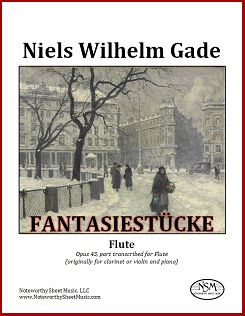 Fantasiestücke, Op.43, by Niels W. Gade
Fantasiestücke, Op.43, by Niels W. GadeTranscribed for Flute and Piano by J. W. Pratt
Flute Part, PDF $6.99
Niels Wilhelm Gade (1817–1890) became the preeminent figure in 19th century Danish musical life after an early success in Copenhagen and five years in Leipzig as Mendelssohn's assistant and successor. His Fantasiestücke (Fantasy Pieces, Opus 43) for clarinet (or violin) and piano were published in 1864, apparently his only work published that year although others were in progress. They are dedicated to the clarinetist "Herrn Kammermusiker Mozart Petersen." Our flute transcriptions take into account the nature of the flute and the discrepancies between Gade's original score and the clarinet and violin parts. The piano score is readily available in the public domain, as a free pdf download of the score for clarinet and piano. Here is a link to one such source: Piano Score
Flute part, 7 pages; Total, 10 pages.
Preview -
Gaubert - Deux Esquisses - Clarinet and Piano
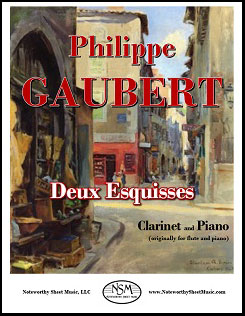 Deux Esquisses, by Philippe Gaubert
Deux Esquisses, by Philippe Gauberttranscribed for Clarinet and Piano by C. A. Vater
Clarinet part and Piano score, PDF $9.99
Philippe Gaubert was a prominent French flutist, composer, and conductor who held a professorship at the Paris Conservatory and principal conducting positions at the Paris Opéra and the Orchestre de la Société des Concerts du Conservatoire. We’ve created a transcription of his Deux Esquisses (Two Sketches) for B♭ clarinet, complete with piano score. These pieces were written for flute and piano but are nicely adaptable for other winds. They were originally published by Heugel & Cie, in 1915 (No.1) and 1914 (No.2), and are now in the public domain. No.1, Soir sur la Plaine (Evening on the Plain), opens intriguingly with the solo instrument playing alone, repeating a single note. This motif sets the lovely, mysteriously forlorn tone of Soir sur la Plaine, and returns multiple times later in the piece. No.2, the second sketch, is Orientale, which, as its name suggests, evokes an atmosphere seemingly strange and foreign, Eastern.
Piano Score, 10 pages; Clarinet part, 4 pages; Total, 20 pages.
Preview -
Gifford - The Pied Piper of Hamelin - An Operetta
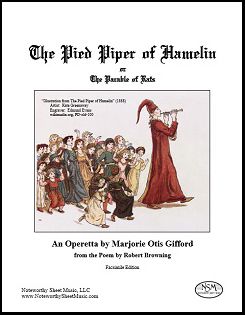 The Pied Piper of Hamelin, by Marjorie Otis Gifford
The Pied Piper of Hamelin, by Marjorie Otis GiffordAn Operetta, from the Poem by Robert Browning
Facsimile Edition by Noteworthy Sheet Music, LLC, PDF $24.99Marjorie Otis Gifford (1909-2003) was a composer, choirmaster, and long-time music and piano teacher in CT and NY. At age 24, she put music to Robert Browning's classic poem The Pied Piper of Hamelin, creating a children's operetta for her students. In her preface to the operetta, Mrs. Gifford states that perhaps the best performance of The Pied Piper was at the Lenox School in NYC, where she was teaching in 1938; that production was directed by Antoinette Perry, who later became known as 'Tony' of the Tony Awards. Indeed, there are additional famous personalities and much fascinating history associated with the remarkable life of Marjorie Otis Gifford.
The Pied Piper of Hamelin operetta was brought to NSM's attention by Gale Finlayson, daughter of composer and music educator Walter Finlayson, and we created our facsimile edition of the operetta at Gale's request. Marjorie Otis Gifford and Walter Finlayson were great friends, and in her preface Mrs. Gifford credits Mr. Finlayson with putting her operetta down on paper. NSM has received permission to publish the operetta from both the executor of Mrs. Gifford's estate and from Deborah O'Connor, the artist who created the charming illustrations that grace the internal pages of the operetta. We hope that, in publishing our facsimile edition, we can contribute to sustaining the legacy of Marjorie Otis Gifford and enabling future generations of young music students to perform and enjoy her work.
Marjorie Otis Gifford's The Pied Piper of Hamelin operetta was performed by the Rutland Youth Theatre of Rutland, VT, on March 2, 2018; click the link to visit YouTube and watch clips of this performance videotaped and posted by Ms. Finlayson.
Score with music and lyrics for voices and piano accompaniment, 67 pages; text of the Robert Browning poem addendum, 7 pages; Total, 78 pages.
PreviewPlease use the Contact Us link to order The Pied Piper of Hamelin operetta PDF. Upon receiving your request, we will send you an invoice via PayPal and, once PayPal acknowledges receiving your payment, we will email a copy of the PDF to you directly.
-
Glazunov - Elegy - Flute or Alto Flute
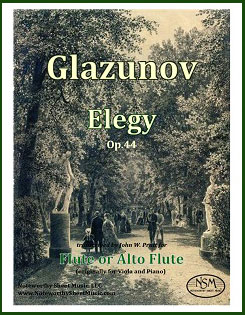 Elegy, Op.44, by Alexander Glazunov
Elegy, Op.44, by Alexander GlazunovTranscribed for Flute or Alto Flute (and Piano) by John W. Pratt
Parts for Flute and Alto Flute, PDF $5.99
Alexander Konstantinovich Glazunov (1865-1936) was a major composer in the late Russian romantic tradition. His Elegy, Op.44, was written for viola and piano in 1893. The viola melody is readily adaptable for other instruments, since it is without double stops, and has been transcribed here by John W. Pratt for either flute or alto flute. The piece is about 6 minutes long, elegiac but not lugubrious. It consists of a lovely melody in 9/8 time, enhanced by a simple but warm piano accompaniment. The NSM edition includes a flute part and an alternative alto flute part, but does not include one for piano, since a suitable score is freely available at IMSLP.org.
Flute part, 2 pages; Alto Flute part, 2 pages; Total, 8 pages.
Preview -
Goepfart - Zwei Charakterstücke - Alto Flute and Piano
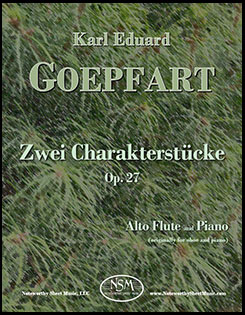 Zwei Charakterstücke, by Karl Eduard Goepfart
Zwei Charakterstücke, by Karl Eduard Goepfarttranscribed for Alto Flute and Piano by C. A. Vater
Alto Flute part and Piano score, PDF $8.99
Karl Eduard Goepfart (1859-1942) was a German pianist, composer and conductor. His Zwei Charakterstücke, Op. 27(Two Character Pieces) were written for oboe and piano and first published in Leipzig in 1888. The two contrasting pieces are the very charming Mässig schnell, gehend and Mässig langsam (in ruhiger Bewegung)with its playful, energetic Lebhaft section. We prepared a transcription of this under-appreciated work for alto flute, complete with piano score. The pieces work well on alto flute, providing the accompanying pianist is sensitive to the alto flute’s lower sound power and projection capability, especially in the low register, compared to that of the oboe.
Piano Score, 8 pages; Alto Flute part, 3 pages; Total, 16 pages.
Preview -
Hauptmann - Bereavement - Alto Flute & Piano
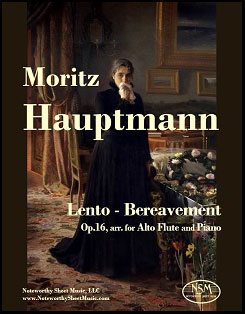 Lento - Bereavement, by Moritz Hauptmann
Lento - Bereavement, by Moritz HauptmannTranscribed for Alto Flute and Piano by C. A. Vater
Piano Score and Alto Flute Part, PDF $3.99
Hauptmann's 3 Violin Duos, Op.16 were first published in 1832. The Lento (Bereavement) from Op.16 later was arranged for violin and piano by the renowned violinist, violist, and composer Heinrich Wilhelm Ernst. It is this arrangement by Henri Ernst, published in 1880, that served as the basis for NSM’s transcription of the piece for alto flute and piano. The mournful simplicity of the Lento is perfectly captured and beautifully rendered by the alto flute.Alto Flute part, 1 page; Piano Score, 2 pages; Total, 6 pages.
Preview
-
Hauptmann - Lieder - Voice, Violin/Flute, Piano
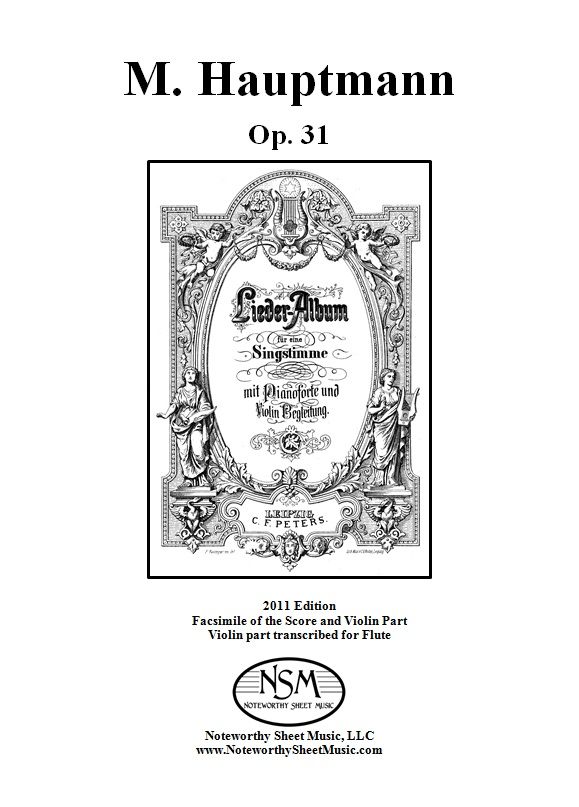 Meerfahrt, Nachtgesang, and Der Fischer, Op.31, by M. Hauptmann
Meerfahrt, Nachtgesang, and Der Fischer, Op.31, by M. HauptmannFacsimile Edition plus a Transcription of the violin part for Flute by C.A.Vater
Score for Violin, Voice, & Piano, Violin Part, and Flute Part, PDF $18.75
Moritz Hauptmann (1792-1868) was a renowned music theorist, pedagogue, violinist, and composer. In 1842, at Mendelssohn's recommendation, he was appointed cantor at the Thomasschule and professor of composition at the newly founded Leipzig Conservatory. Hauptmann published a major scholarly work on music theory in 1853, "Die Natur der Harmonik und Metrik" (The Nature of Harmony and Meter), as well as some 60 compositions.
Hauptmann's Op.31 comprises three lovely songs scored for voice with accompaniment of violin and piano: No.1, Meerfahrt (Sea Voyage); No.2, Nachtgesang (Night Song); and No.3, Der Fischer (The Fisherman). The vocal range extends from B3 to G5, and thus is well-suited for mezzo-soprano. These pieces were published by C. F. Peters as part of a larger volume, now in the public domain, entitled "Lieder-Album für eine Singstimme mit Pianoforte und Violin Begleitung". Our edition contains an "enhanced" facsimile of the original, plus a new transcription of the violin part for flute created using a modern music notation program. The three songs may be performed with comparable gratification utilizing the accompaniment of either violin or flute, along with the voice and piano.
Score, 15 pages; Violin part, 5 pages; Flute part, 5 pages; Total, 29 pages.
Preview -
Haydn - Adagio from Sym. No.24 - Afl & Pf
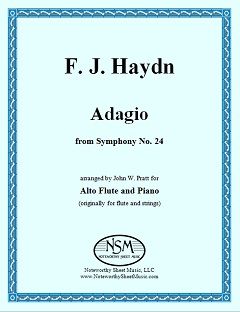 Adagio from Symphony No.24, by F. J. Haydn
Adagio from Symphony No.24, by F. J. HaydnArranged for Alto Flute and Piano by John W. Pratt
Alto Flute Part and Piano Score, PDF $6.00
We offer a flute and piano edition of the gorgeous second movement Adagio for solo flute accompanied by strings from Haydn's Symphony No.24. An arrangement for alto flute that is mellower than that for flute but also extremely beautiful is obtained by lowering the pitch a minor third. Haydn's flute part needs no other change, nor does the cadenza that was written by Mr. Pratt for our C-flute edition. The string parts have been adapted to piano sonority in a number of ways, as well as transposing them in this alto flute edition.
Alto Flute part, 2 pages; Alto Flute & Piano score, 4 pages; Total, 10 pages.
Preview -
Haydn - Adagio from Sym. No.24 - Flute & Piano
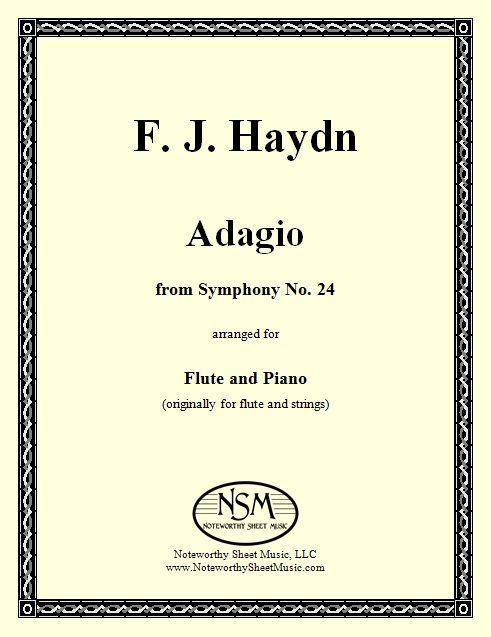 Adagio from Symphony No. 24, by F. J. Haydn
Adagio from Symphony No. 24, by F. J. HaydnArranged for Flute and Piano by John W. Pratt
Flute Part and Piano Score, PDF $6.00
Franz Joseph Haydn (1732-1809) wrote his Symphony No. 24 in 1764. The second movement is a beautiful Adagio for solo flute accompanied by strings, with a place for a cadenza. We offer here a piano transcription of the string accompaniment, with appropriate adaptations in sonority, and the flute part with a written cadenza based closely on Haydn's material and style. Players will find the resulting one-movement flute sonata both affecting and highly rewarding.
Flute part, 2 pages; Flute & Piano score, 4 pages; Total, 10 pages.
Preview
======================================================
We also offer a professionally-printed hard copy edition of the Haydn Adagio for $13.49 plus a $5.95 shipping and handling fee. Due to prohibitively high international shipping rates, we ship print editions only to addresses in the USA. Please use the Contact Us form to let us know which hard copy publication(s) you would like to purchase, along with your email contact information and USPS mailing address. We will then send you a PayPal invoice for the sale and, once we receive notice from PayPal that you have paid for the item(s), we will ship your music to the address provided for delivery in 7-10 business days.
-
Haydn - Adagio, Quartet Op.17, No.1 - Afl & Pf
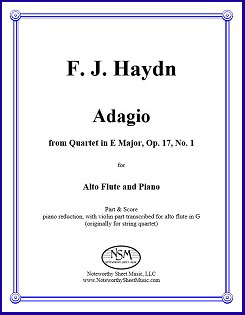 Adagio from Quartet in E Major, Op.17, No.1, by F. J. Haydn
Adagio from Quartet in E Major, Op.17, No.1, by F. J. HaydnTranscribed for Alto Flute and Piano by John W. Pratt
Alto Flute Part and Piano Score, PDF $8.00
Haydn's early quartets, especially the three sets of six written between 1768 and 1771 (Opus 9, Opus 17, and Opus 20), advanced the development of the classical string quartet enormously in all respects. The third movement of Opus 17, No. 1 is an Adagio with a beautiful violin melody that is harmonized simply by the other three strings. Whereas Haydn's more complex movements generally are unsuitable for transcription, the relative simplicity of this gorgeous Adagio makes it an exception. We present here a transcription for alto flute and piano. The melody is highly effective on the alto flute, and the other string parts are readily adaptable to the piano.
Alto Flute part, 2 pages of music; Piano score, 6 pages; Total, 12 pages.
Preview -
Haydn - Adagio, Quartet Op.17, No.2 - Afl & Pf
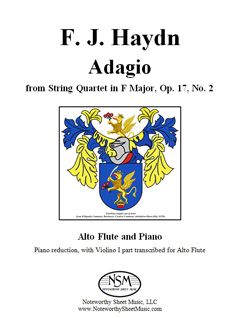 Adagio from Quartet in F Major, Op.17, No.2, by F. J. Haydn
Adagio from Quartet in F Major, Op.17, No.2, by F. J. Haydn Transcribed for Alto Flute and Piano by John W. Pratt
Alto Flute Part and Piano Score, PDF $8.00
The third movement of Haydn's Opus 17, No. 2, like that of Opus 17, No. 1, is an Adagio with a beautiful violin melody that is harmonized simply by the other three strings. The melody is compelling on alto flute, with just a few changes to accommodate its sonic differences from the violin. Lest the effect be too placid when the lower string parts are transferred to the piano, our piano transcription elaborates them in the style of Haydn's keyboard music in several places. We also incorporate a few changes for better sonority and to disentangle the voices where the string parts have overlaps and unisons that are poorly suited to the piano. All told, this transcription is highly effective and a delight for both players.
Alto Flute part, 2 pages of music; Piano score, 6 pages of music; Total, 12 pages.
Preview -
Haydn - Adagio, Quartet Op.20, No.5 - Fl & Pf
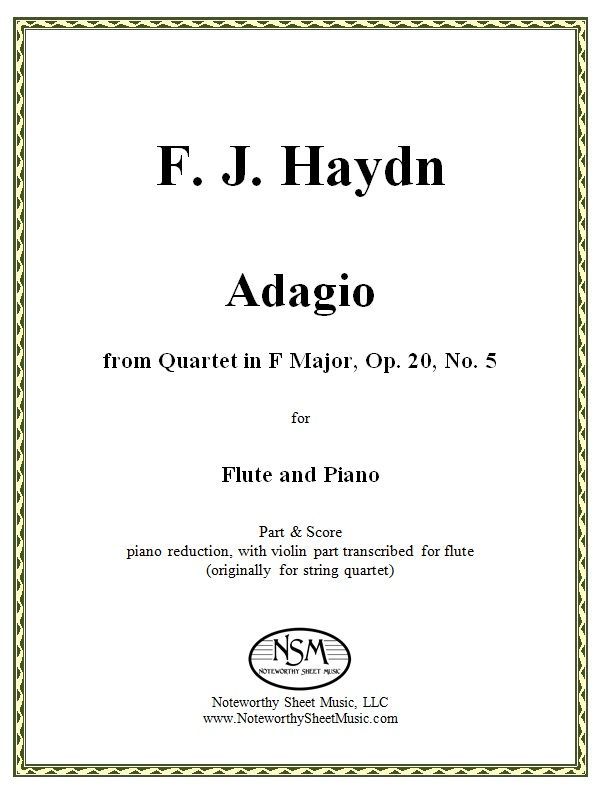 Adagio from Quartet in F Major, Op.20, No.5, by F. J. Haydn
Adagio from Quartet in F Major, Op.20, No.5, by F. J. HaydnArranged for Flute and Piano by John W. Pratt
Flute Part and Piano Score, PDF $10.00
The third movement of Haydn's string quartet Opus 20, No. 5 is an Adagio with a simple melody that is treated to delightful filigreed elaboration and obbligato decoration by the violin. Although more complex quartet movements are typically unsuited to transcription, in this beautiful Adagio the soloistic nature of the violin part and the simplicity of the lower string parts lend themselves very well to an arrangement for flute and piano, as in the fine transcription we offer here.
Flute part, 3 pages of music; Piano score, 7 pages of music; Total, 14 pages.
Preview -
Kalliwoda - Concertino - Alto Flute
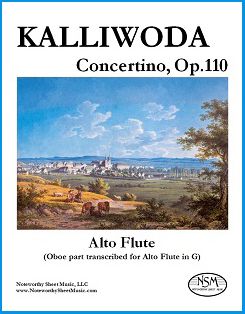 Concertino, Op.110, by J. W. Kalliwoda
Concertino, Op.110, by J. W. KalliwodaTranscribed for Alto Flute by C.A.Vater
Alto Flute Part ― PDF $6.99
Johann Wenzel Kalliwoda (1801‒1866) was a Bohemian violinist, orchestra conductor, and prolific composer who wrote numerous compositions, including operas, symphonies, various works for violin and orchestra, piano pieces, and chamber music works. He was considered a significant composer in his day, especially for pieces written early in his career, and his music received the praise of Robert Schumann. Kalliwoda was immensely popular and a favorite of American concert-going audiences in the first half of the 19th century.
His Concertino, Op.110, for oboe and orchestra was first published by Schott in 1841. An arrangement of the work for oboe and piano is available on imslp.org, in addition to an orchestral score and parts for oboe, violins I and II, violas, cellos, and basses. Like many of Kalliwoda's earlier compositions, the Concertino is highly melodic and energetic. We created a transcription of the solo oboe part for alto flute that gives alto flutists an opportunity to experience first-hand the joy of playing this style of classical 19th century bravura work, for which the alto flute is well-suited. Perhaps it should be pointed out that Theodore Boehm, who developed the modern alto flute in G during the mid-1850's, intended that the alto become a new instrument in its own right, utilized in a variety of musical roles and characterized by a unique quality of sound. Indeed, we think Boehm likely would have approved of our creating new opportunities, such as this transcription of the Kalliwoda Concertino, to show off the alto flute's versatility and the alto flute performer's virtuosity.
We provide our alto flute part only; appropriate parts for piano or orchestral accompaniment may be obtained as free pdf downloads from public domain resources, such as imslp.org.
Alto Flute part, 7 pages; Total, 10 pages.
Preview -
Kalliwoda - In die Ferne - Voice, Violin/Flute, & Piano
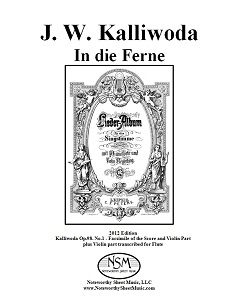 In die Ferne, Op.98, No.1, by J. W. Kalliwoda
In die Ferne, Op.98, No.1, by J. W. KalliwodaFacsimile Edition plus Transcription of Violin part for Flute by C.A.Vater
Score for Violin, Voice, & Piano, Violin Part, Flute Part, PDF $5.99
Johann Wenzel Kalliwoda (1801‒1866) was a Bohemian violinist, conductor, and composer who spent much of his career in Donaueschingen, where he served as the conductor of the court orchestra for Prince Karl Egon II of Fürstenberg. Kalliwoda composed numerous works, including operas, symphonies, pieces for piano, violin and orchestra, and chamber music.
Kalliwoda's song In die Ferne (Far Away) was published in a nineteenth century collection of lieder, along with several songs by Hauptmann and Reinecke. The vocal range of In die Ferne extends from E4 to G#5, and thus is well-suited for either soprano or mezzo-soprano. Our edition contains "enhanced" facsimiles of the original score (violin, voice, and piano) and violin part, plus a transcription of the violin part for flute created using a modern music notation program. Therefore, In die Ferne may be performed using the accompaniment of either violin or flute, along with the voice and piano.
Score, 6 pages; Violin and Flute parts, 1 page each; Total, 12 pages.
Preview
===============
U.S. customers may purchase professionally-printed hard copies of In die Fernefor $10.18 plus a $5.95 shipping and handling fee. Please use the Contact Us form to let us know which print edition(s) you would like to purchase, along with your contact information and your USPO mailing address. -
Lane - Seven Rants - Wind Quintet & Piano
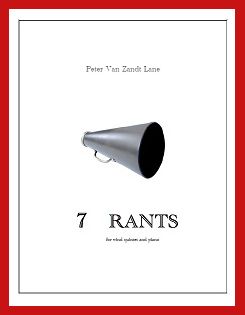 Seven Rants, by Peter Van Zandt Lane
Seven Rants, by Peter Van Zandt LaneContemporary Composition for Flute, Oboe, Clarinet, Horn, Bassoon, and Piano, PDF $0.00
Peter Van Zandt Lane was commissioned to compose this piece for the 67th Composers Conference and Chamber Music Workshop at Wellesley College, which took place in the summer of 2011. The annual Conference is a wonderful two-week event, which brings together prominent young composers, superb professional musicians, dedicated amateur chamber musicians, and enthusiastic listeners. The professional musicians premiere the composers' new works and also coach the amateur musicians in chamber ensembles. Concerts are free and open to the public. For more information on the program, please visit the Composers Conference website.
After the Conference each year, one of the composer fellows is selected to create a new work for the next year's chamber music workshop participants. That composer returns the following summer to coach two groups of players on the new composition, in preparation for performances in the Saturday evening concerts of Week I and Week II. Peter Van Zandt Lane's Seven Rants was an enormous success in 2011, absolutely loved by the players and received exceptionally well by the audience. Written for flute, oboe, clarinet, horn, bassoon, and piano, Seven Rants is a series of seven delightful and diverse movements. The first and last movements are strict palindromes. The five middle movements or "rants" are "mini-concertos", each highlighting a different wind instrument. Great fun to play, and highly accessible.
With permission from both the composer and the Wellesley Composers Conference and Chamber Music Center, Noteworthy Sheet Music is thrilled to offer our customers a free PDF download of Seven Rants by Peter Van Zandt Lane. And please check out more of this terrific young composer's work, including two other listings in the NSM catalog, Danzas Mecánicas and Transverse Fractures.
Score, 37 pages: Flute part, 10 pages; Oboe part, 9 pages; Clarinet part, 10 pages; Horn part, 9 pages; Bassoon part, 9 pages; Piano part, 15 pages; Total, 103 pages.
-
Lane - Transverse Fractures - Flute & Piano
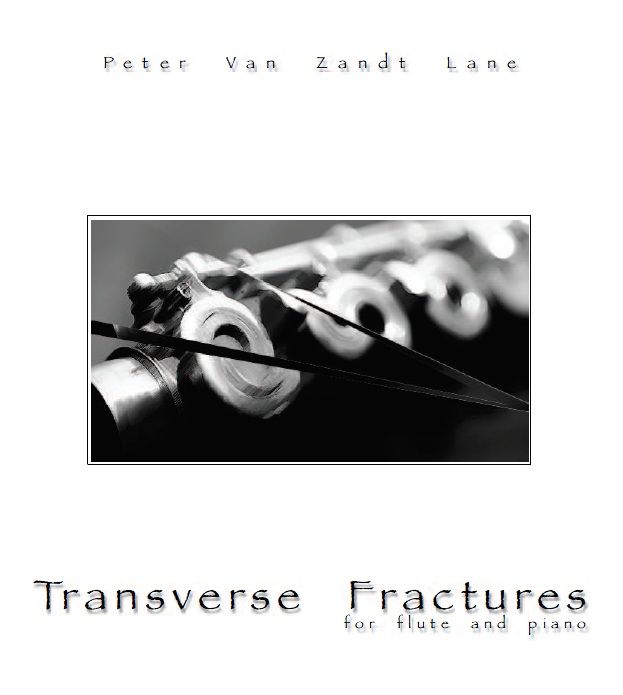 Transverse Fractures, by Peter Van Zandt Lane
Transverse Fractures, by Peter Van Zandt LaneContemporary Composition for Flute and Piano, PDF $20.00
Peter Van Zandt Lane's compositions have been featured on various festivals and conferences such as the New York City Electroacoustic Music Festival, Spark Festival, FEASt Fest, SEAMUS National Conferences, Forecast Music, Festival Miami, and LIPM/IEMS at the world renowned Teatro Colón in Buenos Aires. He has received awards in several competitions including the CRS Young Composers competition, the Forecast Music International Composers Competition, The Greater Miami Youth Symphony Composition Competition, and the Cleveland Orchestra Miami Residency Call for Scores. He has been a finalist twice for the ASCAP/SEAMUS Student Commission, and is an active member of the Composers in Red Sneakers, one of the country's longest-running composer consortiums.
Transverse Fractures (2009) is a short, virtuosic, high-energy duet for flute and piano. The piece was derived from a larger, longer chamber work entitled Partial Fractures, which the composer wrote for NotaRiotous Ensemble. Transverse Fractures, approximately 5 minutes long, is a piece of considerable difficulty for both the flutist and the pianist.
Piano Score, 13 pages; Flute Part, 7 pages; Total, 23 pages.
Preview -
Loeffler - 4 Poèmes - Clarinet (Voice, Clarinet and Piano)
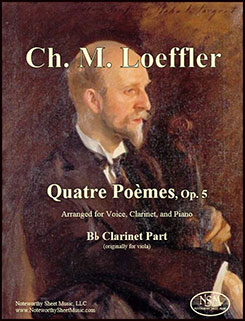 Quatre poèmes pour voix, alto et piano, by Charles Martin Loeffler
Quatre poèmes pour voix, alto et piano, by Charles Martin LoefflerViola part transcribed for Clarinet by C.A.Vater
Part for B-flat Clarinet; PDF $10.99
Noteworthy Sheet Music’s transcription of the viola part for Brahms’ Two Songs for Alto, Viola, and Piano, Op. 91 for clarinet quickly became one of our most popular editions, so we wanted to please our customers with another voice, clarinet, and piano option. We decided to create a clarinet version of the poems famously set to music by Charles Martin Loeffler (1861-1935). Quatre Poèmes pour Voix, Alto et Piano, Op. 5 was premiered by the Boston Symphony Orchestra with Loeffler himself on viola. In these four songs, Loeffler set to music one poem by Charles Baudelaire (“La cloche fêlée”) and three poems by Paul Verlaine (“Dansons la Gigue!”, “Le son du cor s’afflige vers les bois”, and “Sérénade”). Each of these songs has a unique character but Loeffler’s love of color variations and dense harmonies can be heard throughout the set.
We have taken care to adapt the viola part to the clarinet as conservatively as possible, and we think it works well. Obviously, there are places where we had to make modifications, and occasionally some difficult choices—for example where the viola has double stops, goes out of clarinet range, or uses harmonics or pizzicato. We encourage clarinetists who plan to perform this piece to listen to recordings of these songs with viola, and to consult the original viola part and score, available as free PDF downloads from imslp.org. Our edition includes only the transcribed clarinet part.B♭-Clarinet part, 10 pages; Total, 14 pages.
Preview